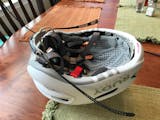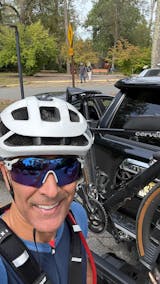A Quick Guide to Mountain Biking Glasses

First things first, the most important job glasses for mountain biking must do is protect your eyeballs from physical assaults. Think dust, mud, dirt, pebbles, bugs, and branches. The best sunglasses for mountain biking must protect your eyes from UV rays and physical impacts. Second, high-quality optics should help you see the trail and its obstacles faster, with more clarity and better depth perception, so you can avoid unexpected obstacles like a tree stump suddenly appearing in the middle of the trail. Third, the best mountain biking sunglasses should fit well. The perfect pair should fit on your face just under your mountain bike helmet and stay on while you’re charging down bumpy terrain.
Please note: This guide is specific to cross-country mountain biking, not downhill or terrain park mountain biking. For those gravity-assisted derivatives, full-face goggles — and full-face helmets — are recommended.
The Best Sunglass Lens Colors for Mountain Biking, Ranked
Red, Copper
This is the best all-around color for all conditions. You’ll enjoy high contrast, better clarity, and impressive depth perception with these colors. They aren’t the darkest, so you can still see well when riding through deep forest trails or on cloudy days, but they have enough color to handle direct sunlight.
Red, Purple
This color is best for flat light or cloudy days. If you’re riding snow-free trails in the winter, these are worth looking into. Same if you ride in foggy coastal environments.
Colors to Skip
Black or gray lenses cut glare but do nothing to heighten contrasts or depth perception like the colors above can. Yellow lenses’ efficacy is limited to dim light or overcast days but not the gamut of light conditions that other lens colors can handle. Last, clear lenses are fantastic for night rides — and that’s about it.
Now a Word About Visible Light Transmission Ratings
Each of the colors mentioned above will have a Visible Light Transmission (VLT) rating. Listed as a percentage, the rating explains how much visible light reaches your eyes. Here’s a quick breakdown of the rating scale:
0-15%: Super dark lenses, excellent for bright sun (Brown, Black, Mirrored)
16-40%: Ideal for all-purpose, all-conditions mountain biking sunglasses (Red, Copper, Purple)
40%+: Perfect for low-light, fog, and dusk/dawn conditions
The Best Sunglasses Lenses for Mountain Biking
Trivex lenses, such as Rudy Project’s ImpactX lenses, are the most impact- and shatter-resistant lenses available. The material’s durability has been approved by the military, making it the top choice for protection. These protective lenses are flexible enough to curve around your face without negatively affecting your field of vision. Glass provides the best optics but is heavier, not shatter resistant, and isn’t produced for sports wrap frames. These limitations make Trivex the best all-around lens material. Most sport sunglasses are made with impact-resistant polycarbonate lenses, but Trivex is stronger and clearer.
Polarization, Photochromic, and Other Options for Mountain Biking Glasses
Polarized sunglasses are ideal for water and snow sports; they block horizontal light, such as the blinding glare you deal with on a boat or ski slope. Since there isn’t any water in the mountains, polarized lenses are not recommended because you won’t get the same improved depth perception, something you absolutely must have dialed in for mountain biking on technically challenging trails.
Photochromic lenses automatically transition from clear in dark environments to dark in bright sun. Their secret sauce is the injection of UV-sensitive molecules that react to the presence of UV rays and light into the lens itself. Now, with the advent of colored photochromic lenses, wearers can conceivably get by with one pair of mountain biking glasses for every trail. However, the transitions take several seconds to work. It’s not instantaneous.
Anti-fog treatments are worth pursuing. Grinding uphill on a hot, muggy day without enough air flowing through your lenses will cause them to fog up. Same for riding on a cold, damp day in the winter. An anti-fogging coating ensures you can see, so you’ll keep your glasses on your face, not in your helmet or pocket. Now, a good deal of keeping your lenses fog free comes down to your sunglasses' ability to ventilate, moving cool air through the glasses and letting hot air vent. The Vent Controller feature on Rudy Project performance sunglasses does one better; it lets you adjust how much air can flow through your lenses and dry out any moisture inside.
The Perfect Size and Fit for Your Mountain Bike Glasses
When it comes to sunglass lens size, ample coverage is the key. The width should be slightly past the corner of your eyes, and the depth should be just above and not touching your cheeks. Find the lens that fits comfortably on your face yet still tucks under your mountain biking helmet. An ample coverage lens means a larger field of protected and clear vision. That makes it easier to spot the branch sticking out to snare your wheel out of the corner of your eye. Rudy Project’s Spinshield, Spinshield Air, and Cutline deliver the perfect combination of protection and clarity.
The biggest lens you’re comfortable with depends on how the sunglass frames fit. And in mountain biking, a snug fit is more critical than weight — although premium sunglasses in this category will usually be lightweight anyway. Try a pair on and do what you can to try and shake the glasses off your head. Next, do the same while wearing your mountain bike helmet. The top of the glasses shouldn’t hit the bottom of your helmet, and the arms shouldn’t get in the way of the straps or retention band behind your ears.
Found the frames with the lens color you want? Then get riding!









